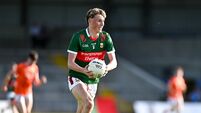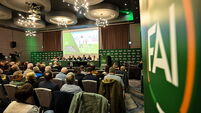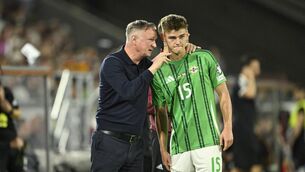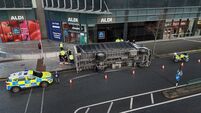A test of how far this Ireland has come...and has yet to go
Martin O’Neill said on the eve of the game that he wanted the team to “evolve” in terms of “style and pattern of play” but it is already following a few distinct trends of the Derry manager’s career.
At their best last night, Ireland resembled Celtic 2000-03. At their worst, there was the occasional haplessness of his recent Sunderland side.
Either way, the Irish are already very identifiably an O’Neill team.
If that seems rather early, given that this is just the third match of the new regime and comes on the back of an extended break, it was evident here by the first 10 minutes.
The opening goal, in fact, illustrated so many of the manager’s key requirements: extreme intensity, heavy running, work down the wing and the occasional long ball.
Ireland may have got lucky that a defender enjoying as good a season as Branislav Ivanovic committed such an atrocious error in the eighth minute, but it could also be fairly well argued that Shane Long fully forced that luck.
In a manner that will have had O’Neill purring, the Hull forward chased down Antonio Rukavina, before running around the side to opportunistically take advantage of Inavovic’s slip.
Many of Ireland’s best moments thereafter came from a similar source: sudden bursts of power, often from the wing.
James McClean sought particular joy down the right, and twice came close to catching goalkeeper Vladimir Stojkovic off his guard.
It would be incorrect, however, to state Ireland were only about the old-fashioned values of vigour and running.
There was a pleasing composure to some play early on.
In that, though these kinds of friendlies struggle to raise the pulse, this match was quite instructive. Serbia are exactly the kind of mid-ranking technical side that tended to out-pass Giovanni Trapattoni’s Ireland, and are also similar in overall quality to Euro 2016 opponents Poland and Scotland.
As such, this was a telling demonstration as regards how far Ireland have come under O’Neill, but also how far they still have to go. The reality is that it all is not exactly right straight away.
In between those early bouts of quick attacking, Ireland did use the ball well and passed it around the middle in order to actually allow those sudden surges.
There was always a productive change of pace, if also an element of power.
Glenn Whelan best displayed that with a superb block and challenge that stopped one Serbian run in its tracks.
In the backline, meanwhile, Richard Keogh put in one ferocious tackle on Dusan Basta that will at least lessen any concerns about the future of the central defensive area without Richard Dunne.
The worry for O’Neill was the eventual laxness that may well be a consequence of all that early work, and that let Serbia slip through a few too many times.
It was a measure of how much O’Neill still has to do that, on the first occasion when Ireland properly let their framework fall, Serbia worked their way right through for the equalising goal.
It was a similar story for the second strike, as Filip Dordevic found himself in enough space to prod home and make it 2-1.
That is probably the most pressing lesson of the night for O’Neill: to work to ensure that tightness remains and that the pace of the early stages is more spread out over the entire game.
That would prove influential, rather than just instructive.











